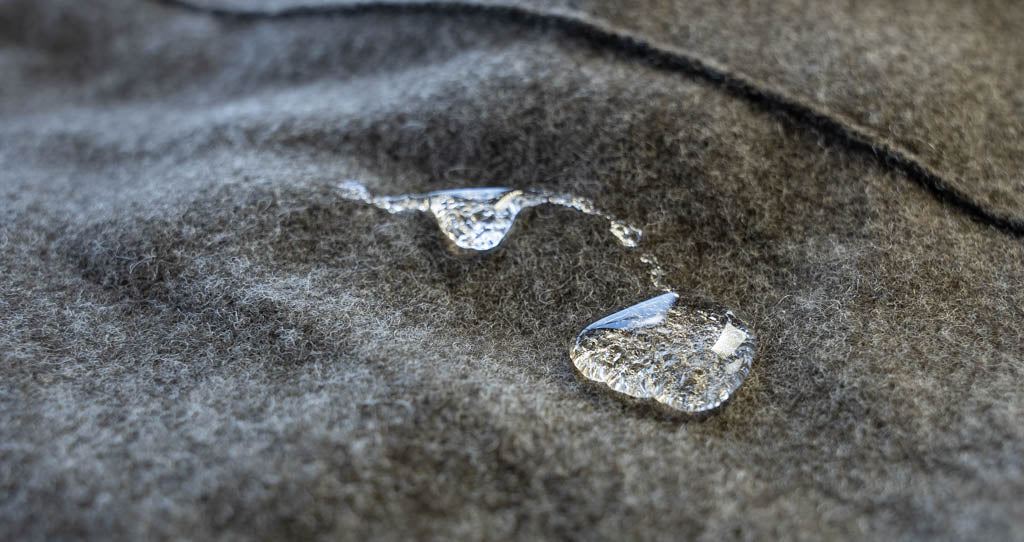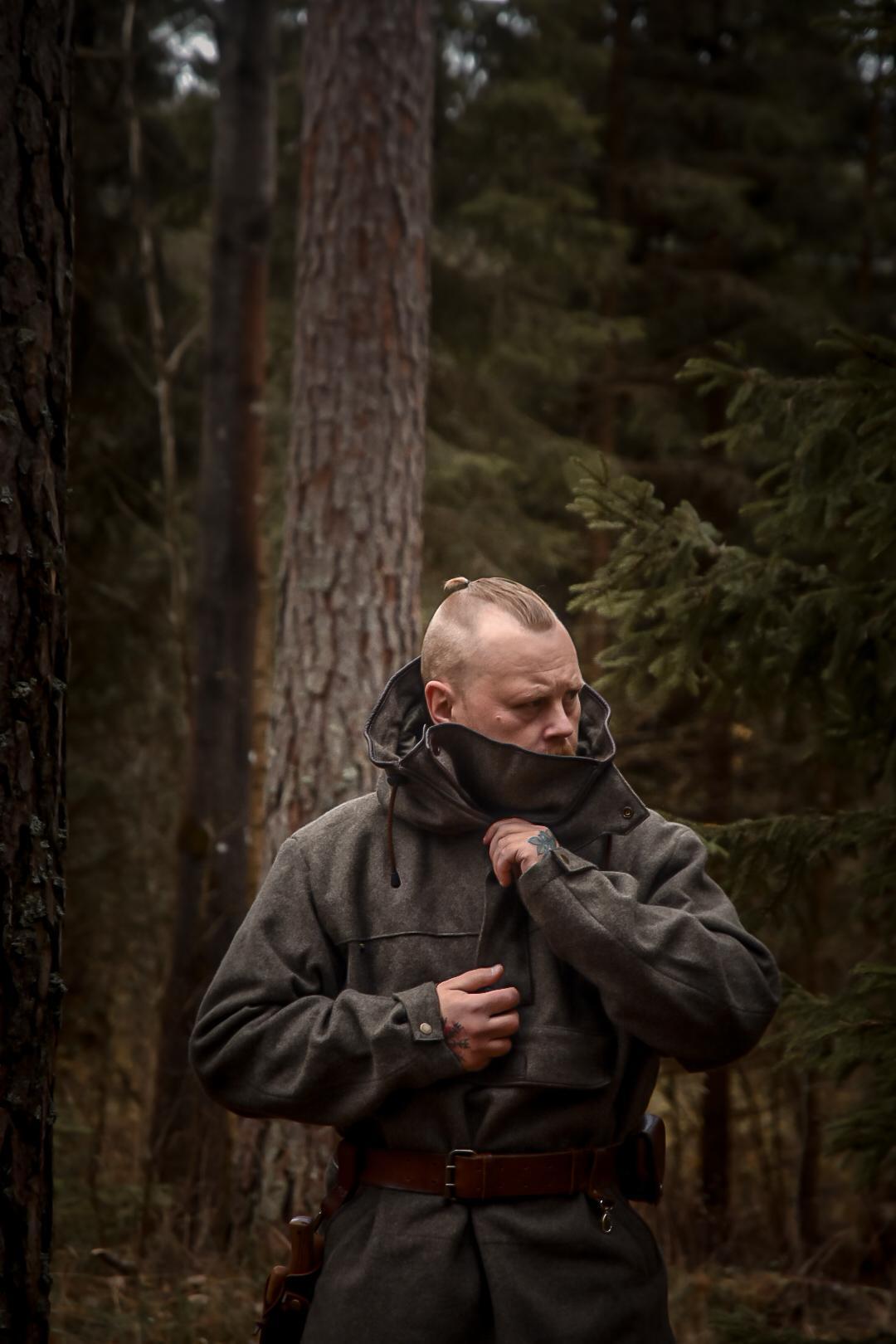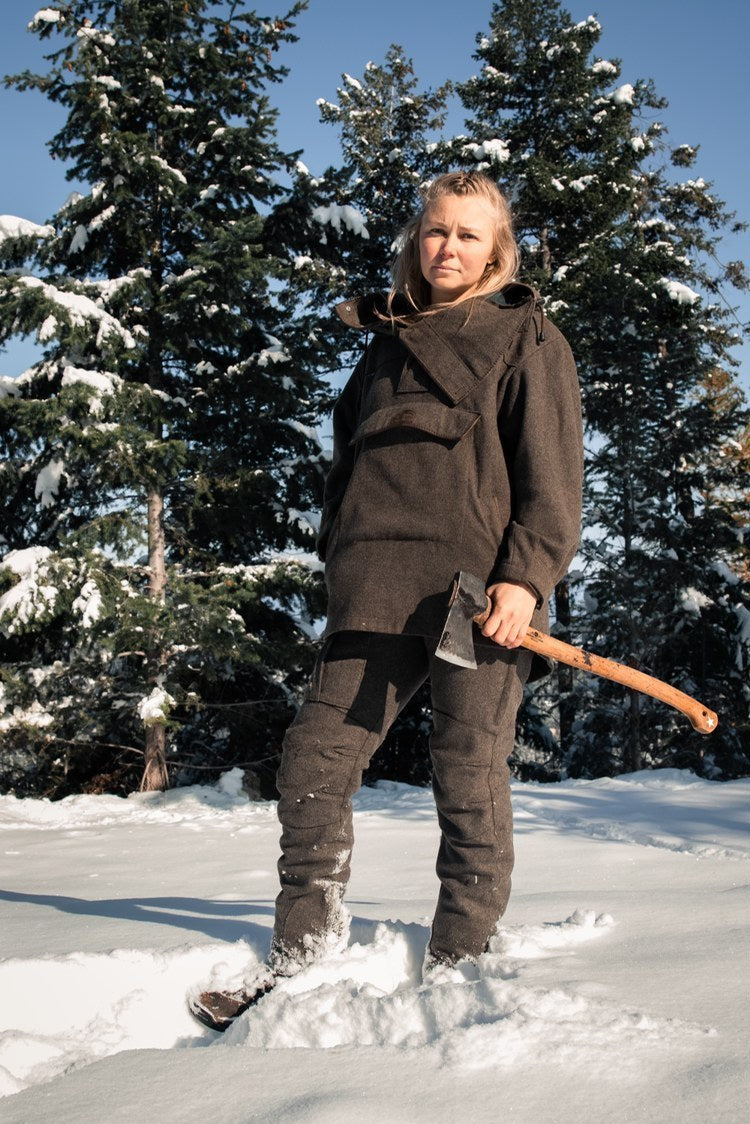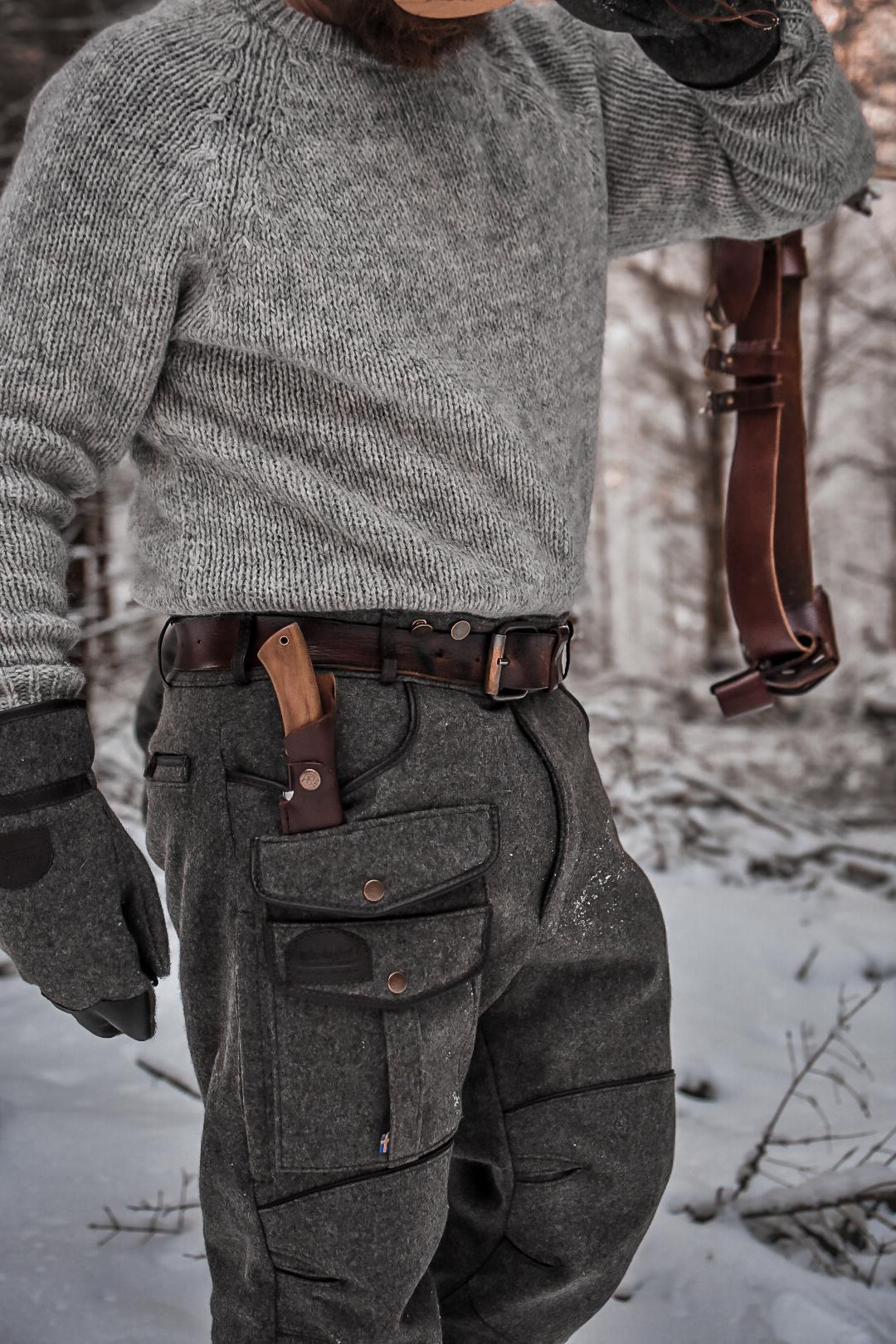Everything you need to know about wadmal outdoor clothing

What is wadmal?
Wadmal (or vadmal) is a felted wool fabric with awesome properties for outdoors- and hunting garments.
The vikings used it to make clothes for surviving the grim nordic winters. People on the northern hemisphere have been using Wadmal clothes ever since they domesticated sheep. Germans called it Loden and the brittish had their Tweed.
No matter what you call them, wadmal garments are durable and comfortable in any conditions. They are warm and almost entirely wind- and water proof. Yet they magically wick sweat and moist produced by your body, like a modern membrane-fabric. But better.
In fact, many synthetic fibres are trying to mimic the characteristics of wool. Some have come a long way in their development, but they still can’t compare to wool in warmth, comfort and durability.
The unique properties of wool
To understand all the unique properties of Wadmal you must know what features wool brings to textiles.
Two contradictory properties
Wool has two astonishing, but contradictory properties:
- The fat and the proteins in the outer cell layer are tightly bound together, making the fibre completely waterproof. The fibre is coated with lanolin, which repel water and fights smelliness by inhibiting bacterial growth.
- At the same time the fibre will absorb more moist than any other textile.
Wool absorbs and holds up to 35% of its weight in water before it gets saturated. That might be a world record for textiles, since cotton only absorbs 18% and nylon 8%. As a result, wool will absorb much more moist before it feels wet on you.

Image by: CSIRO, CC BY 3.0
Why does that matter? Well, the ability to absorb moist is invaluable for clothes that are supposed to be warm. Her is why:
Stays warm because of moist absorption
When textiles are saturated with moist they strive to dehydrate. To do that they suck heat from its environment (you) to evaporate the absorbed water, wich will make you… yes, you guessed it: freeze.
Try running in a cotton sweater on a warm summerday and you’ll get the point. As soon as it gets wet, you get cold, even in warm weather.
That’s why it’s a huge advantage to wear garments that has a high capacity for moist absorption, like wool.
But here’s the best part about wool:
Wool generates its own heat
When wool absorbs moist the fabric generates heat chemically. Water molecules wanders into the fibre, which translates to kinetic energy, according to a formula:
In normal room temerature and 25% humidity, one kilogram of wool holds about 50 grams of water. If you increase the air temperature by ten degrees celcius and the humidity to 95%, the wool absorbs another 270 grams of water from the air. In the process it will generate enough heat to melt half a kilogram of ice, in the process.
In fact, wool generates five times more heat than any other textile.
So, what then, is Wadmal and how is it made?
Wadmal is a wool textile that has been processed to achieve a thicker, more durable and waterproof fabric.
Tiny scales makes felting possible
If you look at the wool fibre in a microscope you’ll discover that it has tiny scales directed from its root to the tip. These ”epidermal scales” gives wool the ability to felt itself.

Image by: CSIRO, CC BY 3.0
Fibres attach to eachother like velcro
When the wool absorbs moist the fibre swells, making the epidemal scales rise. If you stomp, roll and knea wool textile in warm water the scales will latch on to eachother like velcro. As a result the fabric will be reinforced and toughened.
Processing strengthens the fibres
The more you process the fabric the tighter the fibres will bind to one another, making the cloth thicker and stronger, and at the same time creating a random arragnement of the fibrese. According to Norman R. S. Hollies and Martha M Kaessinger this makes the slows down the water transporting speed and increases thermal insulation in the moist state. If you keep it up you will eventually end up with a wind- and waterproof, almost impenetrable, yet soft fabric called Wadmal.
Micklagaards wadmal is military grade
About 30 years ago the Swedish military announced that they were discontinuing the use of wadmal in their uniforms.
We’re talking top notch, military grade wadmal, that has been silicone impregnated for increased waterproofing.
It’s made to withstand years of abuse, crawling muddy foxholes and what not.
The military auctioned out the remaining fabric, and Micklagaard bought the entire lot. We have a barn with stacks and stacks of vacuum packed wadmal, waiting to be made into clothes.
Doesn’t rip
This particular wadmal is unique. It’s made of 80% wool, reinforced by 20% extremely durable Rayon celluluse fibres. It weighs 840 gr/square meter and will last you a lifetime. The military made shure that this fabric would keep their soldiers warm and protected no matter what. It doesn’t even rip, because the threads aren’t arranged in straight lines.
Protects against sharp objects
It’s not imptenetrable, but offers increased protection against knives and sharp objects. Like wool, this breed of wadmal doesn’t ignite easily, which is why it’s been used to make fire fighting uniforms.
Silent enough for sneak attacks
Every once in a while the military needs to surprise the enemy with a sneak attack. To stay undetected they wanted their uniforms to be silent. If you rub synthetic fabrics against itself it usually makes a loud noise, but wadmal is virtually silent. An invaluable feature for hunters.
Heavier than most
It’s hard to find anything negative about wadmal. It sure is heavier than most other fabrics, and some people don’t like the grey colour.
Synthetic fabrics vs wadmal
There are lots of modern synthetic fabrics on the market. Some of them offer great functionality. They’re usually very light, and can be made wind- and waterproof while remaining breathable, just like wadmal.
But there are some important differences:
Synthetics can’t bind water vapour
Engineers have tried to develop synthetic fibres that mimic wools ability to absorb water. Plastic fibres with cappilary holes and tiny cracks increase their ability to absorb and transport water. But since they can only absorb liquid water, they lack wools ability to bind water vapour in the material itself.
As a result synthetic fibres still can’t generate heat chemically.
Synthetics builds static electricity
When you move, your clothes rub against your body, which builds up static electricity. Since wool contains water naturally, static charges aren’t built up as easily as in synthetic fabrics.
Synthetics consume lots of resoruces
Producing synthetic fibres consumes lots of resources, and generates carbon emissions. Wool is a completely natural and renewable resource.
Wool is energy efficient
As natural as it is, wool has a very energy efficient composition. It degrades slowly, because the molecules themselves have nothing to gain from parting from one another. Which means the wool fibres are extremely durable.
Reluctant to catch fire
Because of the low amounts of energy contained in wool, it is very reluctant to catch fire. Synthetic materials may burn and melt into sticky hot drops that can cause great harm to anyone who wears it.
How to care for wadmal clothes
Wool should be handled with care. Wadmal clothes rarely needs washing, because they repell most of the dirt and bad smelling sweat.
Since wool only absorbs water vapour, the moist that it takes in is practically destilled water. Dirt and odorants are to large molecules to pass the outer cell layers of the wool fibre.
Airing is usually enough
After using your wadmal garment, hang it out for airing. During airing there is a natural exchange of water molecules between the wool fibre and the surrounding air. The water molecules will lift dirt and odorants with it, leaving the wool clean and odorless.
Hand wash cold
If you really do need to wash your wool clothes, you should hand wash in cold water with a wool detergent. Spin dry carefully, don’t twist it.
Leave it to dry on a well ventilated flat surface. When it is dry it is good to go.





your on my wish list
Wonderful product and Wadmal a great material but there is space to use other materials something like G1000 on high exposure areas that provide more water resistance and dry quicker. areas such as thighs knees hoods and shoulders. Can avoid getting soaked but walking in wet grass passing under wet branched will saturate these areas and take a while to dry. raglans sleaves and shoulder yokes in the jaket designs will also help by repositioning the seams away from horizontal surfaces. Ideally you would want to build a system that can cater for all conditions. Same traditional material with a modern twist
I need hunting clothes for cold weather. I need information about pants and layering that’s recommended for very cold conditions. I’m finding it difficult to access the information I need through the website. Is a catalog available? Thank you.
I have recently had the pleasure to order a made to measure Kebne Jacket, the measurements were ease to take following the videos, all the communications were prompt and the couple of extra measurements requested were to perfect the fit of the Jacket. Delivery was prompt, the jacket’s fit was perfect and the quality of the finish far exceeded my expectations. I can not highly enough recommend Micklgard and the team that work there for the quality and customer service.
I have recently had the pleasure to order a made to measure Kebne Jacket, the measurements were ease to take following the videos, all the communications were prompt and the couple of extra measurements requested were to perfect the fit of the Jacket. Delivery was prompt, the jacket’s fit was perfect and the quality of the finish far exceeded my expectations. I can not highly enough recommend Micklgard and the team that work there for the quality and customer service.
Leave a comment